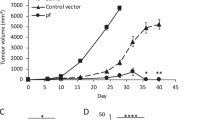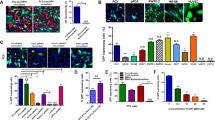Abstract
We demonstrate that fusion proteins consisting of the herpes simplex virus (HSV) transport protein VP22 linked in frame to HSV thymidine kinase (tk) retain the ability to be transported between cells. In vivo radiolabelling experiments and in vitro assays show that the fusion proteins also retain tk activity. When transfected COS cells, acting as a source of the VP22-tk chimera, were co-plated on to gap junction-negative neuroblastoma cells, ganciclovir treatment induced efficient cell death in the recipient neuroblastoma cell monolayer. No such effect was observed with COS cells transfected with tk alone. Tumours established in mice with neuroblastoma cell lines expressing VP22-tk regressed upon administration of ganciclovir. Furthermore tumours established from 50:50 mixtures of VP22-tk transduced and nontransduced cells also regressed while no significant effect was observed in similar experiments with cells transduced with tk alone. VP22 mediated transport may thus have application in a clinical setting to amplify delivery of the target protein in enzyme-prodrug protocols.
This is a preview of subscription content, access via your institution
Access options
Subscribe to this journal
Receive 12 print issues and online access
$259.00 per year
only $21.58 per issue
Buy this article
- Purchase on Springer Link
- Instant access to full article PDF
Prices may be subject to local taxes which are calculated during checkout






Similar content being viewed by others
References
Marcel T, Grausz JD . The TMC Worldwide Gene Therapy Enrollment Report, end 1996 Hum Gene Ther 1997 8: 775–800
Ram Z et al. Therapy of malignant brain tumors by intratumoral implantation of retroviral vector-producing cells Nature Med 1997 3: 1354–1361
Verma I, Somia N . Gene therapy problems, promises and prospects Nature 1997 389: 239–242
Bi WL, Parysek LM, Warnick R, Stambrook PJ . In vitro evidence that metabolic cooperation is responsible for the bystander effect observed with HSVtk retroviral gene therapy Hum Gene Ther 1993 4: 725–731
Freeman SM et al. The ‘bystander effect’: tumor regression when a fraction of the tumor mass is genetically modified Cancer Res 1993 53: 5274–5283
Dilber MS et al. Gap junctions promote the bystander effect of herpes simplex virus thymidine kinase in vivo Cancer Res 1997 57: 1523–1528
Ishii-Morita H et al. Mechanism of ‘bystander effect’ killing in the herpes simplex thymidine kinase gene therapy model of cancer treatment Gene Therapy 1997 4: 244–251
Ruch RJ . The role of gap junctional intercellular communication in neoplasia Ann Clin Lab Sci 1994 24: 216–231
Shinoura N et al. Protein and messenger RNA expression of connexin43 in astrocytomas: implications in brain tumor gene therapy J Neurosurg 1996 84: 839–845
Elliott G, O’Hare P . Intercellular trafficking and protein delivery by a herpesvirus structural protein Cell 1997 88: 223–233
Vrionis FD et al. The bystander effect exerted by tumor cells expressing the herpes simplex virus thymidine kinase (HSVtk) gene is dependent on connexin expression and cell communication via gap junctions Gene Therapy 1997 4: 577–585
Kuriyama S et al. Tissue-specific expression of HSVtk gene can induce efficient antitumor effect and protective immunity to wild-type hepatocellular carcinoma Int J Cancer 1997 71: 470–475
Vile RG, Hart IR . Use of tissue-specific expression of the herpes simplex virus thymidine kinase gene to inhibit growth ofestablished murine melanomas following direct intratumoralinjection of DNA Cancer Res 1993 53: 3860–3864
Rosolen A et al. In vitro and in vivo antitumor effects of retrovirus-mediated herpes simplex thymidine kinase gene-transfer in human medulloblastoma Gene Therapy 1998 5: 113–120
Lechanteur C et al. HSV-1 thymidine kinase gene therapy for colorectal adenocarcinoma-derived peritoneal carcinomatosis Gene Therapy 1997 4: 1189–1194
Melcher A et al. Tumor immunogenicity is determined by the mechanism of cell death via induction of heat shock protein expression Nature Med 1998 4: 581–587
Wallace H et al. Ganciclovir-induced ablation non-proliferating thyrocytes expressing herpes virus thymidine kinase occurs by p53-independent apoptosis Oncogene 1996 13: 55–61
Hamel W, Magnelli L, Chiarugi VP, Isreal MA . Herpes simplex virus thymidine kinase/ganciclovir-mediated apoptotic death of bystander cells Cancer Res 1996 56: 2697–2702
Vile RG et al. Systemic gene therapy of murine melanoma using tissue-specific expression of the HSVtk gene involves an immune component Cancer Res 1994 54: 6228–6234
Klatzmann D . Gene therapy for metastatic malignant melanoma: evaluation of tolerance to intratumoral injection of cells producing recombinant retroviruses carrying the herpes simplex virus type 1 thymidine kinase gene, to be followed by ganciclovir administration Hum Gene Ther 1996 7: 255–267
Ramesh R et al. In vivo analysis of the ‘bystander effect’: a cytokine cascade Exp Hematol 1996 24: 829–838
Phelan A, Elliott G, O’Hare P . Intercellular delivery of functional p53 by the herpes virus protein VP22 Nat Biotechnol 1998 16: 440–443
Miller AD, Rosman GJ . Improved retroviral vectors for gene transfer and expression Biotechniques 1989 7: 980–990
Pear WS, Nolan GP, Scott ML, Baltimore MA . Production of high-titer helper-free retroviruses by transient transfection Proc Natl Acad Sci USA 1993 90: 8392–6
Boussif O et al. A versatile vector for gene and oligonucleotide transfer into cells in culture and in vivo: polyethylenimine Proc Natl Acad Sci USA 1995 92: 7297–7301
Honess RW, O’Hare P, Young D . Comparison of thymidine kinase activities induced in cells productively infected with herpes virus saimiri and herpes simplex virus J Gen Virol 1982 58: 237–249
Author information
Authors and Affiliations
Rights and permissions
About this article
Cite this article
Dilber, M., Phelan, A., Aints, A. et al. Intercellular delivery of thymidine kinase prodrug activating enzyme by the herpes simplex virus protein, VP22. Gene Ther 6, 12–21 (1999). https://doi.org/10.1038/sj.gt.3300838
Received:
Accepted:
Published:
Issue Date:
DOI: https://doi.org/10.1038/sj.gt.3300838
Keywords
This article is cited by
-
Antitumor potential of a synthetic interferon-alpha/PLGF-2 positive charge peptide hybrid molecule in pancreatic cancer cells
Scientific Reports (2015)
-
Induction of Tumor-specific Immune Response by Gene Transfer of Hsp70-cell-penetrating Peptide Fusion Protein to Tumors in Mice
Molecular Therapy (2010)
-
Fusogenic membrane glycoproteins induce syncytia formation and death in vitro and in vivo: a potential therapy agent for lung cancer
Cancer Gene Therapy (2010)
-
Structure prediction and validation of an affibody engineered for cell-specific nucleic acid targeting
Systems and Synthetic Biology (2010)
-
Therapeutic HPV DNA vaccines
Immunologic Research (2010)



